|
ADVENTURE When big cats come for dinnerBefore their sanctuary disappears, head off to these Indian tiger reserves and game parks where you might recognise a face or two. The awesome T19 has passed away, but her brood continues to jostle for space, prey, and power. Written and photographed by Abhinav Dhar Updated 28 March 2023
SEE ALSO South African Safaris | Bangalore Guide | New Delhi Business Hotels | Goa Resorts Review | Kerala Resorts | Ladakh Guide | Mumbai Business Hotels | Zanskar treks | Bhutan | Nepal Treks | Phuket Guide | Bali Fun Guide | Child Friendly Hotels 
Better days: Regal T19, the seemingly eternal mother of Ranthambhore, is sadly no more. An earlier pose with her cubs at a watering hole. In her heyday she was a force to be reckoned with/ photo: Abhinav Dhar JUMP TO Ranthambhore | Corbett Park | Tadoba | Other Indian Game Parks NOTHING quite prepares you for your first tiger charge - neither Disney’s brilliant animations, nor Kipling’s lilting colonial prose. My moment of truth came on a cool misty February morning in the grasslands of Corbett. And it was nothing like Walt Disney had ever conjured up. My camera was pointed at a patch of tall elephant grass. I was hoping to photograph the heavily pregnant resident tigress. She had just given herself away when the dewy grass blades rustled ever so slightly as she crept closer. It was more of an explosion than a roar. As though a bomb had just gone off. Still fiddling with my settings, from the corner of my eye I saw the blur of a huge projectile, flashing eyes and teeth, tail spinning like a turbine rotor, hurtling towards the jeep. Ears laid flat, she hit the brakes about 10 feet away, skidding sideways in a cloud of dust, like a car trying to avoid a head-on collision. 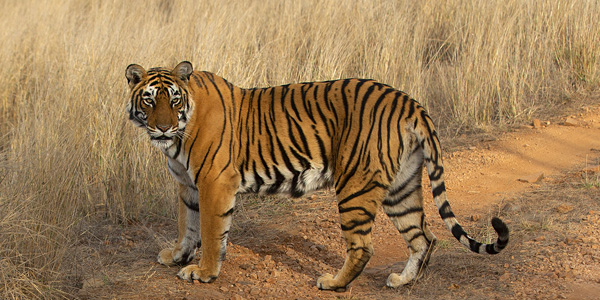
Magnificent Shakti prowls the Ranthambhore winter grasses (early 2023). She is bringing up her own brood/ photo: Abhinav Dhar It was all over in about two seconds. Grunting, she ambled away, seemingly wagging a finger at me and warning not to get this close again because, apparently, she was a new mother now. It was her way of putting up a rather bold ‘do not disturb’ sign outside her nursery. Seeing a wild tiger eye to eye, on her terms, is more life changing than life threatening. More often than not, tiger spotting is an exciting game of hide-and-seek with small clues sprinkled randomly all over the place – a strangely silent and deserted waterhole on a warm evening, a skittish sambar deer stomping his hoof for no obvious reason, a pugmark across a recent jeep track, a nervous langur peering at a lantana bush – all pushing the adrenaline as you await a climactic encounter with the star attraction. No matter where and how it happens, the moment is always mesmeric. Something beautiful and primal stirs within those dulled urban souls. It is virtually impossible to be unmoved by the close-up experience of 220kg of majesty and raw muscle. Indian tigers are served up in a variety of settings. The regal and imposing sal forests of the Himalayan foothills, the stark semi-desert scrub of Rajasthan to the west, the stunningly beautiful gold and green meadows of Madhya Pradesh in central India, and the dramatic floodplains of Assam and West Bengal towards the east and northeast – all home to a rich menagerie of denizens that make up the tiger’s world and, often, its unwitting buffet. 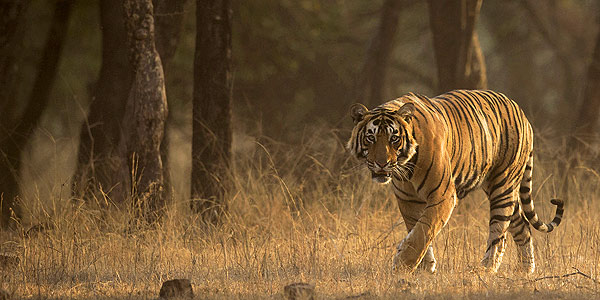
Eternal adolescent, the powerful Pacman pads about Ranthambhore's outer fringes as he gains weight and years to effect a comeback/ photo: Abhinav Dhar Many years of bouncing about on jungle trails across some of these remote wilderness areas in searing heat and freezing winters, I’ve come to know a few tigers, some a bit better than others. They certainly have personalities. Here’s a who’s who of some Indian tigers and a where and how for tiger safaris and up close encounters. Ranthambhore's royal sanctuaryRanthambhore, framed against the ramparts of a 10th century fort, is one of the best places in the world to see a tiger. Ancient ruins, gigantic banyan trees and tigers create an exotic cocktail. The low scrub dotting the landscape makes for high visibility and a big cat against this surrealistic backdrop is worth every bone-rattling thump of the safari vehicle. Once here, you are likely to run into T-19, a leading lady of the park in a very real game of thrones. Send us your Feedback / Letter to the Editor T-19 (now deceased) had one of the most successful reigns in the lakes area of Ranthambhore. Her kind of success in tigerdom is rare. In holding on to prime territory for as long as she did, raising several cubs to adulthood, and fighting off bigger and stronger challengers, she beat the odds every time. It was an incredible tour de force in an environment where the weak perish regularly with nary a sign that they ever existed. 
Arrowhead near Jogi Mahal, Ranthambhore. One of T19's more ambitious cubs she dethroned her mother, banishing her to the outskirts of the scrubland/ photo: Abhinav Dhar T-19 was dethroned by her equally ambitious daughter, Arrowhead (the acorn doesn’t fall far). You might spot this lady on a neighbouring hillside. She ruled the lakes for many years and birthed yet another generation of fierce young rebels, Riddhi and Siddhi, who have since managed to knock Arrowhead off her Iron Throne. The battle of the younger sisters was cut short when Siddhi was removed from the park to help populate a nearby tiger reserve. Riddhi is now the ruling queen. T-19's son, Pacman, was the tiger version of the quintessential six-foot, protein-packed gym-ripped teenager who still talks with an adolescent lisp. Pacman was big and regal but young. He wouldn’t have lasted five minutes against a mature, battle-hardened male. His days of carefree strutting around mum’s hunting grounds are over. He was pushed to the outer fringes of the park. I would look out for a tiger, feeling slightly sorry for himself, with an Eighties-style computer-game marking above his right eye. He was killed by an older male. If Oprah Winfrey, Lady Di and Serena Williams could be rolled up into one big striped cat, it would be Noor. Beautiful, successful, powerful, fearless, efficient, in total control of her life, she would score a 10/10 in any beauty contest while easily maxing an IQ test at the same time. She would also be the last tigress standing on the ‘Survivor’ TV show. She is the much photographed celebrity of the Sultanpur area of Ranthambhore and had her paws full by late 2017 raising three boisterous young adults on the verge of leaving home. The 17-year-old Noor is still alive and active, and stalks the outer fringes of the park. Shakti is another magnificent emerging face in this wildscape. She is building up her own brood and 'kingdom' as humanity comes ever closer into this national park. November through May is ideal for a three-to-four-night visit to this park, which practically guarantees tiger sightings. Keep an eye out for leopards on the cliffs on your way in and out of the park. The reserve is well connected by road and rail and a very doable detour if travellers are on the Jaipur-Agra circuit. From Jaipur airport, it’s a three-and-a-half-hour drive Sujan’s Sherbagh is the place of choice for the well-heeled safari enthusiast. A throwback to the colonial age, its pukka sahib aesthetic is tasteful and elegant with all the modern indulgences you could possibly think of in a jungle setting. Think Indian and European gourmet dining and personalised pampering. This is an intimate Indian luxury tented camp comparable to the finest in Africa. Run by Anjali and Jaisal Singh, whose family pioneered wildlife conservation in Ranthambhore, the camp's roasted tomato soup just before the afternoon safari will linger on your palate for many years. 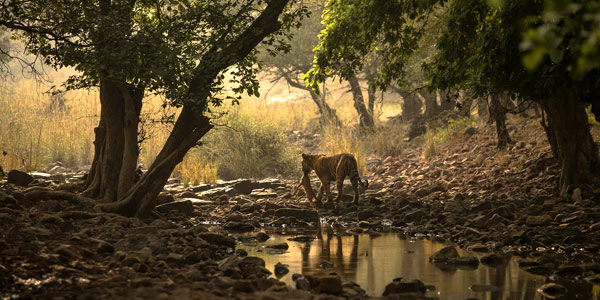
Tigress Noor heads off with her kill for some quiet time to enjoy some fresh venison by a watering hole/ photo: Abhinav Dhar Balendu Singh’s Dev Vilas is one of the better ways of experiencing a tiger safari in Ranthambhore. It will appeal to the value conscious but this is no shack on a budget. It's a solid well set up space. More like a Rajasthani estate with large open spaces and sprawling lawns, it has big rooms with their unique, pièce de résistance – two loos! (Brilliant, considering crack-of-dawn safari wake-up calls with families scrambling pink-eyed to get ready). The vibe is informal and friendly helpful staff will respond to your whims with good cheer. A chance to listen to Balendu's jungle stories every evening by the fire, toting a cigar and a glass of good Merlot, with three Great Danes lolling about your feet, is what makes this place so homey and special. There are several luxury hotels in the vicinity – the tented Aman-i-Khas and the Oberoi Vanyavilas among them – and other less wallet-numbing family stay options. Corbett jungle camouflageIf Jungle Book ever came to life, along with all its assorted characters, it would be as Corbett National Park. Nestled in the Himalayan foothills, it is India’s first tiger reserve dating back to 1936. Named after Jim Corbett the celebrated British Army officer who authored Maneaters of Kumaon and various books in between hunting, observing, and finally saving tigers, the park's unique mosaic of streams, rivers, ridges and grasslands also make it one of the prettiest. The cherry on this pie would be an unexpected encounter with Sher Khan while you are busy marvelling at other distractions like the amazing birdlife and huge elephants herds floating across the breezy grasslands. Historically, the tigers of Corbett tended to be shy and elusive, but of late they have become more comfortable with camera-toting travellers often lumbering around elephant-back. 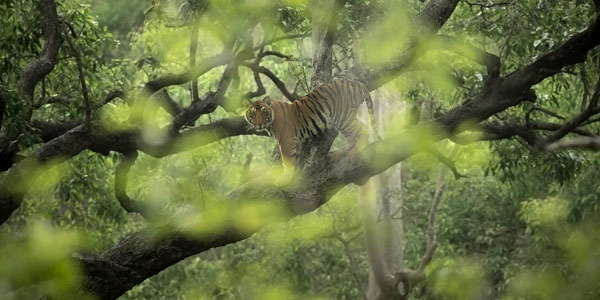
Tiger manages to clamber up a tree at Corbett National Park set in the lush forests and marshlands at the foot of the of the Himalayas. Corbett was the first national park set up in India in 1936/ photo: Abhinav Dhar One of the tigresses responsible for this change of attitude is Sharmeeli, (or the Shy One). So named because she avoids eye contact, Sharmeeli was anything but when our paths crossed a few years ago. When one of her four cubs decided to play ‘leopard’ and climb all the way to the top of a mango tree, she had the forest reverberating like a rock concert with her disapproving growls. Whether it was a fear of heights or the very real threat of a serious bollocking by an angry mother that kept him riveted high up the tree, I’ll never know. Corbett has many options for accommodation. As far as high end lodges go, Jim’s Jungle Retreat is a good bet. In the thick of Corbett’s natural beauty and birdsong, it is also just five minutes from the Jhirna gate. The resort has a no-plastic policy and grows most of its own food. Plush cottages with private bonfires and organic fine dining make it feel like the forest just went posh just for you. The local Kumaoni cuisine is a must try. Corbett is the only park in India that allows you to spend a few nights inside the forest. There is no nicer way to experience Corbett. Dhikala & FRHs located within the park can be booked in advance. Though the guesthouses themselves are somewhere between basic and functional, they are in spectacular locations. A great way to do this is to book an organizer/guide for a couple of nights in the Dhikala zone, which is the most scenic and active core of the forest. Dheeraj Singh & Bigshot adventures are India tiger safari outfitters who deliver an end-to-end experience. Carrying their own food, linen, amenities and good humour, they transform the basic to impressively nice, and they are great forest guides. 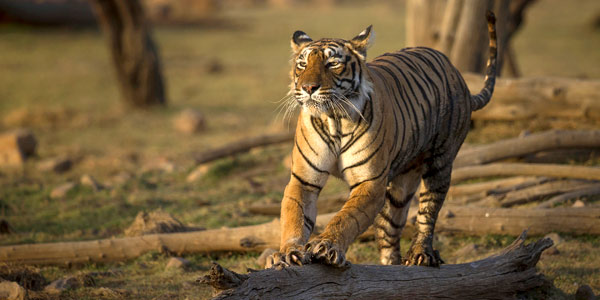
T19, the original park elder, seen here sharpening her claws in the golden light of a Ranthambhore evening/ photo: Abhinav Dhar Early December through May is the best time to be in Corbett. Morning drives during the winter months demand long johns or other thermal underwear and some serious layering up. A five-and-a-half-hour drive from Delhi or a train to Ramnagar and an easy car shuttle gets you to this haven, quite conveniently. Tadoba tiger trailsTadoba in a word? Abundance! Smart tiger conservation practices have made Taboda a modern miracle in central India. It has tigers coming out of its ears to the extent that there are more of them spilling over to the buffer zone than there are, within the park boundary. Tadoba also defies the notion that tiger sightings are a rare and physically distant occurrence. This is a 24x7 theatre for wildlife action and the park is now a very popular destination for photographers and travellers seeking an authentic experience. Leopards, sloth bears, and the mighty Indian bison or ‘gaur’ will happily interrupt your single-minded obsession with the tiger. Tadoba is also home to the highly endangered Indian wild dogs called 'dhole'. Here you might run into Choti Tara, if you find yourself in her neighbourhood. The irony of nicknames extends, even to the tiger world. Evoking Sumo wrestlers named ‘Slim’ or basketball players called ‘Shorty’, Choti Tara or the Little One, is the longest and tallest tiger in Tadoba. Born in 2009, she has been a steady presence in Tadoba. Easily identified because she wears a GPS collar for research purposes, you are more than likely to meet her while rounding a bend near Jamini village. 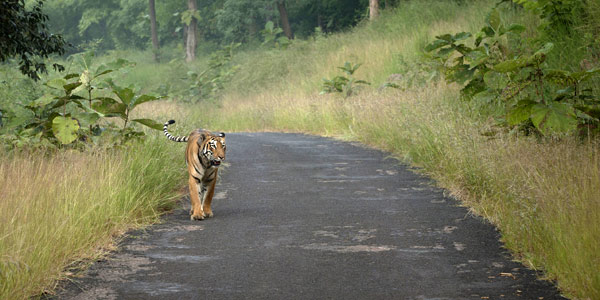
At Tadoba where sightings are numerous as the tiger population swells, Choti Tara (Little Tara) strolls nonchalantly along a jungle road perhaps waiting for the tourist hordes/ photo: Abhinav Dhar Hugging Maasal Lake and adorned with striking tribal art, Bamboo Forest Lodge is the definitive eco- luxury resort in town. Specially customised safari vehicles and experienced naturalists make its game drives very special. By contrast, for the wilderness weary safari goer, who has had one bump too many, the lodge is always a welcome return to perfect temperature showers, air-conditioned chalets, mini bars, cable TV and that ultimate Indian wildlife park blessing, Wi-Fi. With an expansive choice of cuisine on offer, it is worth checking out the 'Jungle Maas' and the 'Chocolate Flora' every time. For a closer to nature vibe, Tigress@Ghosri is a truly special boutique resort that will delight wildlife enthusiasts. Owned and run by an intrepid couple dedicated to conservation, it is a villa on a private conservancy, deep in Tadoba’s now more than lively buffer zone. Cosy, clean and comfortable bedrooms, good home-style comfort food prepared by the resident cook, and you can laze in a fenced-off backyard pool to the accompaniment of distant roars of a patrolling tiger. With wildlife traffic passing through the property regularly, it is highly advisable to spend the evenings indoors watching a live feed of the resort's on-site camera trap. You just might see that distant tiger that you heard in the afternoon, now on the TV screen, sipping from a waterhole just 30 yards outside your bedroom window. Summer in Tadoba is scorching but makes for great sightings for the hardcore crowd. The less weather-tolerant should consider the cooler period November though March. An easy getaway from Mumbai, it is a three-and-a-half-hour ride from Nagpur airport. Other Indian game parksOther tiger destinations in India to experience this magical but fast vanishing world are, Kanha, Pench and Bandhavgarh (Madhya Pradesh, central India), Kaziranga (Assam, in the northeast), The Sundarbans (in West Bengal in the east) and Bandipur (in the south Indian state of Karnataka). Tiger authority extraordinaire Valmik Thapar says tigers have always "captured the human imagination" and "from the beginning of civilisation,they [tigers] have been feared, worshipped, admired, hunted, studied, photographed, written about, immortalised in art and poetry...” As William Blake – who at best probably just managed to spot a gambolling tiger cub at London Zoo – gushed in his 1794 illustrated poem contemplating and immortalising this beast, "Tyger Tyger, burning bright, In the forests of the night; What immortal hand or eye, Could frame thy fearful symmetry?"
NOTE: Telephone and fax numbers, e-mails, website addresses, rates and other details may change or get dated. Please check with your dealer/agent/service-provider or directly with the parties concerned. SmartTravel Asia accepts no responsibility for any inadvertent inaccuracies in this article. Links to websites are provided for the viewer's convenience. SmartTravel Asia accepts no responsibility for content on linked websites or any viruses or malicious programs that may reside therein. Linked website content is neither vetted nor endorsed by SmartTravelAsia. Please read our Terms & Conditions. |





